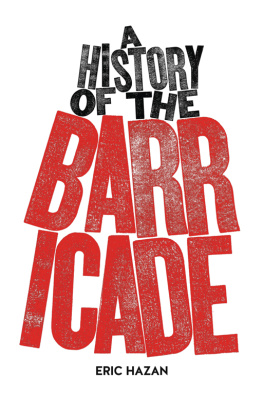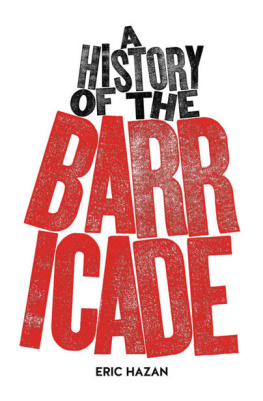The Insurgent Barricade
The publisher gratefully acknowledges the generous support
of the Ahmanson Foundation Humanities Endowment Fund
of the University of California Press Foundation.
The Insurgent Barricade
Mark Traugott

University of California Press, one of the most distinguished university presses in the United States, enriches lives around the world by advancing scholarship in the humanities, social sciences, and natural sciences. Its activities are supported by the UC Press Foundation and by philanthropic contributions from individuals and institutions. For more information, visit www.ucpress.edu .
University of California Press
Berkeley and Los Angeles, California
University of California Press, Ltd.
London, England
2010 by The Regents of the University of California
Library of Congress Cataloging-in-Publication Data
Traugott, Mark.
The insurgent barricade / Mark Traugott.
p. cm.
Includes bibliographical references and index.
ISBN 978-0-520-26632-2 (cloth : alk. paper)
1. RevolutionsEuropeHistory19th century 2. RevolutionsEuropeHistory18th century. 3. InsurgencyEuropeHistory19th century. 4. InsurgencyEuropeHistory18th century. 5. EuropeHistory, Military19th century. 6. EuropeHistory, Military18th century. 7. Barricades (Military science)Social aspectsEuropeHistory19th century. 8. Barricades (Military science)Social aspectsEuropeHistory18th century.
D299.T68 2010
363.32'309409033dc22 2010018190
Manufactured in the United States of America
19 18 17 16 15 14 13 12 11 10
10 9 8 7 6 5 4 3 2 1
This book is printed on Cascades Enviro 100, a 100% post consumer waste, recycled, de-inked fiber. FSC recycled certified and processed chlorine free. It is acid free, Ecologo certified, and manufactured by BioGas energy.
To Patticat
for your willingness to always stand
on the same side of all my barricades
CONTENTS
ILLUSTRATIONS
FIGURES
MAPS
GRAPHS
TABLE
PREFACE AND ACKNOWLEDGMENTS
The construction and defense of barricades, along with the practical and symbolic functions they perform in violent confrontations, have fascinated me since I first undertook the study of French revolutionary history. Part of the barricades allure is its close association with moments of dramatic upheaval and accelerated social change. Equally intriguing to me has been the fact that barricades in their purest form are artifacts of the popular imagination, the collective and spontaneous creations of anonymous crowd members who base their actions on knowledge that has been sustained, transmitted, and applied without the benefit of formal organization or institutional hierarchy. How and why do people manage, despite formidable difficulties and tremendous risks, to re-create the complex sequence of behaviors that typify even the humblest barricade event? And how did these behaviors, repeated at irregular intervals over hundreds of years, end up taking on a cultural meaning that had made the insurgent barricade all but synonymous with the European revolutionary tradition by the mid nineteenth century?
Though this study takes up many aspects of the barricade phenomenon, there are three that remain a consistent focus in the pages that follow. The first has to do with continuities in barricade use. Not only has the concept of the barricade survived intact over several centuries (despite remarkable variations in the physical makeup or method of deployment of the actual structures), but it has given rise to a widely recognized routine of collective action that even inexperienced and otherwise unrelated insurgents can reproduce on a moments notice. Understanding the recurrent quality of the barricade will be a constant preoccupation in this work, beginning with the early chapters. Demonstrating .
Precisely the opposite concern constitutes a second theme of this inquiry: the equally significant discontinuities in barricade use. We begin by noting that barricades underwent a more or less continual process of adaptation and change, largely as a by-product of the opposition between insurgents and repressors that defines the insurrectionary situation. But it is also important to recognize that barricades, which developed as the unique and exclusive property of French society for the first two hundred years of their existence, eventually underwent a process of diffusion that would, in the course of the nineteenth century, make them a pan-European phenomenon. Understanding what made this transformation possible and the pattern and logic of their spread will absorb much of our attention in the middle section of this book.
A third motif, which combines the other two, asks how the function of the barricade has changed over time; and how, paradoxically, the specific shift from pragmatic tactic of insurrection to preeminent symbol of the revolutionary tradition accounts for the persistence of the practice of barricade construction throughout the modern era, when other forms of early-modern protest have disappeared. The final two chapters of the book place these developments in the context of the long-term evolution of methods of contention in the European world, for in the end, the significance of the barricade is its utility as an indicator of the changing dynamic of violent protest and revolutionary transformation.
The research style adopted in this work reflects my commitment to combining the two disciplinary perspectives that have shaped my personal outlook. Trained as a sociologist and personally inclined toward the search for patterns and regularities, I have ended up in a department of history where reliance on primary sources and the importance of context are axiomatic. My work has always been uncomfortably poised between these divergent ways of viewing the world, and while I aspire never to lose sight of either one, they are not always equally well represented or seamlessly integrated in what I write. In this book, there are certain chapters more likely to appeal to the historically oriented reader for whom the setting in which the facts are embedded is crucial; and others that will inevitably be more to the liking of social scientists for whom the attempt to generalize comes naturally. This preface seeks to direct these different but overlapping audiences toward the segments of this work that they will find most rewarding.
Organizing an investigation of this kind around a concept like the barricade may seem unorthodox, but it has its virtues. Insurrections and revolutions are not only infrequent events, but ones whose outcomes and consequences often require years or decades to reveal themselves. They tend to be unplannedor, if not, to be organized in secrecyand in either case are unlikely to generate extensive documentation. The study of individual instances of barricade use, especially the exceptional cases where insurgents are victorious, tends to present an incomplete or distorted view of reality. Alternatively, choosing to focus in a systematic way on a technique of insurrection in generalall instances of barricade usetakes in events both large and small, successful and unsuccessful, and deriving from the sixteenth to the nineteenth centuries. In surveying the full range and diversity of this type of civil conflict, we are able to form a broadly based image of barricade combat. And because the barricade constituted the most striking embodiment of the classic revolutionary episode and therefore elicited frequent comment by contemporary observers, it has been possible to document more than 150 events involving its use during the time period covered by my research.
Next page







